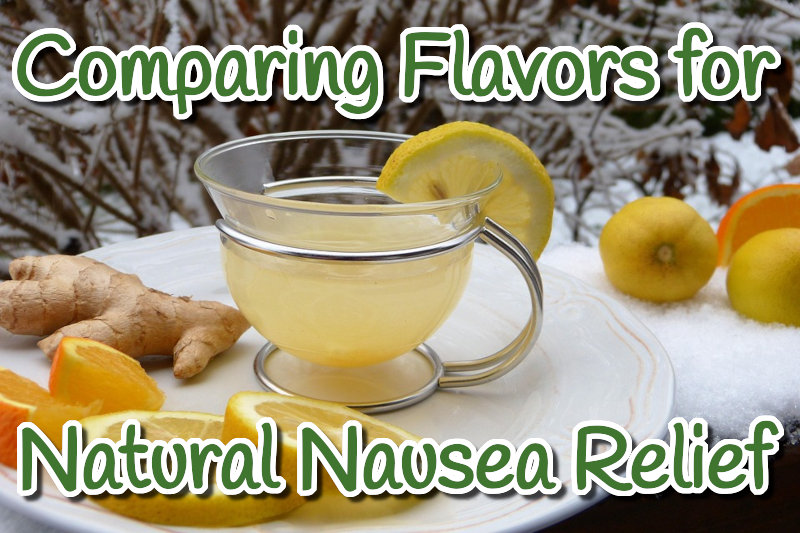Ginger vs Peppermint: Best Natural Flavors for Nausea Relief in 2025

May 31st, 2025 | Motion Sickness, Nausea
The feeling of nausea hits at the most inconvenient times. It can turn a great day sour in seconds, whether it’s from pregnancy, a long car ride, a tough workout, or even stress. Many turn to natural remedies first, and certain flavors stand out: ginger, peppermint, citrus, and chamomile. Their long tradition in home remedies isn’t just folklore—research supports the use of flavors to settle upset stomachs and calm digestion. Let’s take a closer look at how these flavors actually work, and how they stack up against each other in the struggle for everyday comfort.
How Ginger and Peppermint Work for Nausea Relief
Ginger and peppermint have helped people feel better for generations. These flavors aren’t just for taste—they offer relief that’s backed by both tradition and scientific study.
Ginger packs powerful anti-inflammatory compounds and has been used for centuries in teas, candies, and lozenges. Peppermint, with its fresh and cool zing, offers a relaxing effect on stomach muscles and hits the spot in teas and chews for many.
To explore some creative uses for ginger, check out unique ways to use ginger. If you’re curious about other effective options, learn more about natural remedies for upset stomach for a bigger toolkit of flavor-packed helpers.
The Science Behind Ginger for Nausea
Ginger’s secret weapons are gingerols and shogaols. These natural compounds tame inflammation and help block signals in the brain that trigger nausea. Ginger is a go-to option for:
- Morning sickness: Many pregnant people find ginger candies or tea easier to stomach than medicine.
- Motion sickness: Whether you’re on a boat or a winding road, ginger chews can help ward off the urge to hurl.
- Post-surgery nausea: Hospitals even use ginger supplements to reduce queasiness after anesthesia.
Researchers continue to study ginger’s range of uses, but its reputation is already strong. If you’re looking for practical ways to include this root in your routine, explore more unique ways to use ginger.
Peppermint’s Cooling Relief: How It Calms Your Stomach
Peppermint does more than freshen your breath. The key compound here is menthol, which helps relax the muscles of your digestive tract. When your stomach and intestines calm down, cramping and bloating ease—and so does nausea.
A hot cup of peppermint tea after a meal, or a simple peppermint lozenge while traveling, can head off discomfort before it starts. Clinical research backs this up: controlled studies show peppermint oil reduces certain types of nausea and relieves the tough symptoms of irritable bowel syndrome.
Peppermint fits right into the full spectrum of flavor-based effective natural remedies for nausea that bring relief using simple, tasty tweaks.
Other Natural Flavors and Remedies for Nausea
While ginger and peppermint lead the pack, they’re not alone! Citrus, chamomile, and certain bland foods help round out a well-stocked anti-nausea pantry.
Many foods known for easing queasiness have subtle flavors and calming aromas. There’s solid advice and science behind using these as part of a gentle approach.
For more information about how diet plays a part, see this list of Foods to relieve nausea.
Citrus, Chamomile, and More: Expanding the Flavor Toolkit
Citrus fruits, like lemons and oranges, offer a fresh aroma that can cut through the fog of nausea. Just sniffing a lemon wedge or adding a splash of lime to sparkling water can provide quick comfort.
Chamomile stands out for its soothing, anti-inflammatory gifts. A warm mug of chamomile tea helps relax your body and mind, making it ideal for nausea tied to stress or anxiety.
Compared to ginger and peppermint, these flavors bring gentle support. Where ginger and peppermint tackle nausea head-on, citrus and chamomile lend a calming background, perfect for light queasiness or when other flavors feel too strong.
Diet and Lifestyle Tips for Managing Nausea
No flavor can work alone if you ignore what you eat, drink, and do every day. Here are some time-tested tips:
- Stick with bland foods: Crackers, toast, rice, and bananas are easy on your gut.
- Prioritize hydration: Sip water, clear broths, or electrolyte drinks a little at a time.
- Eat small, frequent meals: Avoid big, rich feasts that can upset a sensitive stomach.
- Avoid strong odors: Open a window or step outside if smells turn your stomach.
- Try gentle movement: Sometimes a short walk or slow stretching can help.
Nurturing your system with these simple steps plus flavor-based remedies covers every angle. For more details on practical eating tips, discover more Nausea easing food options.
Conclusion
If nausea is throwing you off course, nature’s own flavors like ginger and peppermint bring proven relief. Ginger tackles inflammation and quiets queasy signals, while peppermint relaxes muscles and cools discomfort. Citrus and chamomile layer in gentle comfort, while bland foods and careful hydration keep your stomach steady.
Mixing evidence-based approaches with natural remedies—and choosing the flavors that suit your palate—gives you real power over nausea. Build your own toolkit, and stay ready for those bumpy days with calm, clarity, and maybe a tasty lozenge or two.
Recent Posts
- Struggling with Chemotherapy Over the Holidays
- Navigating the Holidays with Ease: Managing Travel Sickness While Enjoying the Feasts
- Holiday Travel With Morning Sickness: A Calm Traveler’s Guide
- The Friendly Guide to Keeping Pregnancy Nausea at Bay
- Beat the Morning Sickness Blues: DIY Ginger Remedies for a Calmer Pregnancy
Categories
- All-Natural (4)
- Blog (47)
- Cancer (72)
- Diet (15)
- Holidays (22)
- Lifestyle (67)
- Motion Sickness (44)
- Nausea (103)
- New Mothers (34)
- Oncology Testimonials (3)
- Prebiotics (1)
- Preggie Products (4)
- Preggie Testimonial (23)
- Pregnancy (156)
- Queasy Products (7)
- Queasy Testimonial (17)
